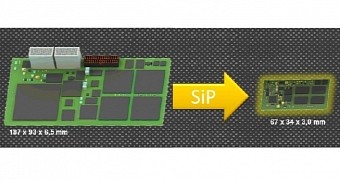According to the rumor mill, Apple is going to roll out its next-gen iPhone 6S sometime in the second part of 2015, and when that happens, we can expect to see the phone arrive with a slimmer than ever waist and a longer-lasting battery.
A new report coming out of Asia via China Times (as seen at G for Games) claims that Apple will adopt the System in Package (SiP) module design for its new phone.
The system is currently used in the newly launched Apple Watch, and if we’re to take the new information as accurate, the Cupertino tech giant is seriously considering implementing SiP into its phone line.
SiP will make the next iPhones slimmer, longer lasting
SiP proved quite crucial for engineers designing the Apple Watch. The technology allowed them to ingeniously stack up internal parts, such as the application processor, memory module, storage and sensors, into a single unit, while freeing up space in the process.
SiP is also responsible for the long battery life the Apple Watch will reportedly offer. The company has managed to make the wearable sustain a life cycle of up to 18 hours on a single charge.
Currently, Apple is using the Printed Board Circuit (PBC), but with the iPhone 6S, the company is expected to make a gradual transition from PBC to SiP. By the time the iPhone 7 comes along next year, SiP will be fully adopted.
Endorsing SiP will allow Apple designers to trim down even further the skinny figures of the current iPhone 6 and iPhone 6 Plus.
As for the extra space left, Apple will use that to supply the phones with bigger battery modules. So in theory, the successor of the iPhone 6 should sustain an impressive life cycle.
New A9 chips will also support long battery life
Advanced power efficiency on the next iPhone is a feature also hinted at by the fact that Apple might source application processors from Samsung, who will manufacture the A9 chips using 14nm FinFET processes.
The most important improvements we’re going to see with the A9 are better CPU performance and high-energy efficiency.
On the other hand, the A9 chips might end up being built by TSMC using “integrated fan-out wafer-level packaging” (inFO-WLP). This technology was announced by TSMC back in 2014, so there’s a good chance Samsung won’t end up scoring the orders after all.
For the time being, you’d better take this information with a big grain of salt. We’ll just have to wait and see as months go by which scenario turns out to be true.

 14 DAY TRIAL //
14 DAY TRIAL //